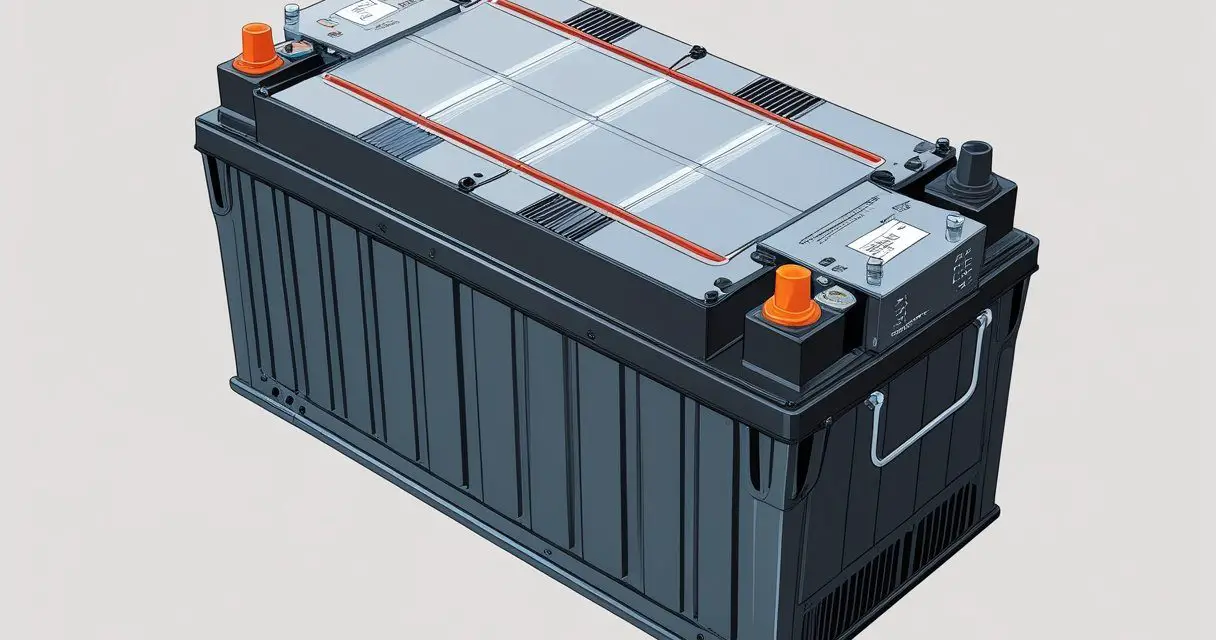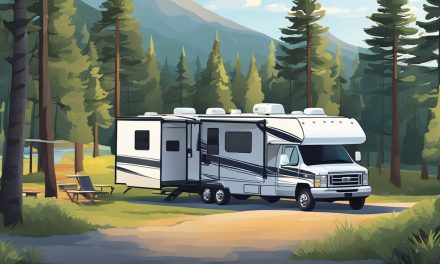Would you like to save this article?
Quick Answer: Yes, But There’s a Big “But”
Yes, your RV can charge lithium batteries – but probably not correctly with your current setup. Most RVs built before 2022 come with charging systems designed for lead-acid batteries, which can actually damage expensive lithium batteries if used without modifications.
The good news? With the right upgrades and knowledge, you can safely charge lithium batteries and unlock amazing benefits like 2-3 times more usable power, faster charging, and batteries that last 10+ years instead of 3-5.
What You’ll Learn
After analyzing dozens of RV lithium battery articles, we found most leave you with more questions than answers. This guide covers everything you need to know, written in plain English that anyone can understand.
What you’ll learn:
- Exactly what happens when you charge lithium batteries with standard RV chargers
- 5 simple ways to check if your RV is lithium-ready
- Step-by-step upgrade options for every budget
- Real costs and timeline for switching to lithium
- Troubleshooting tips that actually work
The Big Problem: Your RV Thinks Lithium Batteries Are Lead-Acid
Here’s what most articles don’t explain clearly: Your RV’s charging system is like a smartphone charger trying to charge a laptop. It might work partially, but it’s not designed for the job.
What Happens When You Use the Wrong Charger
Immediate Problems:
- Incomplete charging – Your battery shows “full” but only charges to 80%
- Overheating risk – Lithium batteries can get dangerously hot
- Battery protection kicks in – Your expensive battery shuts down to protect itself
- Shortened lifespan – Instead of 10 years, your battery might last only 3-4
Long-term Issues:
- Dead battery syndrome – Battery goes to 0% and won’t restart
- Capacity loss – Gradually holds less and less charge
- Voided warranty – Most manufacturers require proper charging equipment
5 Ways to Check If Your RV Can Charge Lithium Batteries
Method 1: Check Your Converter Model
Look for these lithium-friendly converters:
- Progressive Dynamics (with Charge Wizard)
- WFCO with lithium settings
- Victron converters
- Any converter labeled “smart” or “multi-stage”
Red flags (older lead-acid only):
- Single-stage converters
- Converters over 10 years old
- No voltage adjustment options
Method 2: Test Your Charging Voltage
You’ll need: Digital multimeter ($15-30)
Steps:
- Connect to shore power
- Measure voltage at battery terminals
- Good: 14.2-14.6 volts = Lithium compatible
- Bad: Over 14.8 volts = Will damage lithium batteries
- Bad: Under 13.8 volts = Won’t fully charge lithium
Method 3: Look for Lithium Settings
Check your converter panel for:
- “LiFePO4” or “Lithium” setting
- DIP switches with battery type options
- Digital displays with battery selection menus
Method 4: Solar Charge Controller Check
Lithium-compatible controllers:
- Victron SmartSolar series
- Renogy Rover series (newer models)
- EPEver Tracer series
- Any MPPT controller with lithium presets
Method 5: Ask Your RV Manufacturer
Questions to ask:
- “Does my [RV model/year] support lithium batteries?”
- “What converter is installed?”
- “Are any upgrades needed for lithium compatibility?”
Your 3 Upgrade Paths (Budget-Friendly to Premium)
Option 1: The Budget Fix ($150-400)
Best for: Newer RVs with smart converters
What you need:
- Check if your converter has lithium settings
- Add lithium-compatible solar charge controller
- Install battery monitor ($100-200)
Pros: Cheapest option, minimal installation
Cons: Limited if your converter is too old
Option 2: The Smart Upgrade ($400-800)
Best for: Most RVs built after 2015
What you need:
- Replace converter with lithium-compatible model ($250-500)
- Upgrade solar charge controller ($100-200)
- Professional installation (optional, $200-400)
Popular converter choices:
- Progressive Dynamics PD9160ALV – $299
- WFCO WF-8955L – $389
- Victron MultiPlus – $450-650
Option 3: The Complete System ($800-1,500)
Best for: Serious boondockers or older RVs
What you need:
- Premium lithium-specific converter ($400-700)
- DC-to-DC charger for alternator charging ($200-350)
- Smart battery monitor with Bluetooth ($150-250)
- Professional installation ($300-500)
The Lithium vs Lead-Acid Charging Battle
| Charging Stage | Lead-Acid Batteries | Lithium Batteries |
|---|---|---|
| Bulk Stage | 14.4-14.8V for hours | 14.2-14.6V much faster |
| Absorption | Several hours at high voltage | 10-15 minutes maximum |
| Float Stage | 13.2-13.8V continuous | NOT NEEDED (can damage!) |
| Charge Time | 6-12 hours | 1-3 hours |
| Usable Capacity | 50% (can’t discharge below) | 90-95% safely usable |
Key Takeaway: Lead-acid chargers want to “float” at low voltage forever. Lithium batteries hate this and prefer to be charged fast, then left alone.
Real-World Charging Methods That Work
Shore Power Charging
- Equipment needed: Lithium-compatible converter
- Charge time: 2-4 hours for 100Ah battery
- Cost: $200-500 for converter upgrade
Solar Charging
- Equipment needed: MPPT controller with lithium settings
- Charge time: 4-8 hours (depending on sunlight)
- Cost: $100-300 for controller
Alternator Charging
- Equipment needed: DC-to-DC charger
- Charge time: 2-3 hours while driving
- Cost: $200-400 plus installation
Generator Charging
- Equipment needed: Same as shore power setup
- Charge time: 2-4 hours
- Cost: Generator fuel costs
Step-by-Step Installation Guide
Before You Start:
- Turn off all power (shore power, battery disconnect, solar breaker)
- Take photos of existing wiring
- Have a multimeter ready
- Consider hiring a professional for complex installations
Installing a New Converter:
Step 1: Remove old converter
- Disconnect AC and DC wires (label them!)
- Unscrew mounting brackets
- Keep all hardware
Step 2: Install new converter
- Mount in same location
- Connect AC input (black/white/green wires)
- Connect DC output (positive to positive, negative to negative)
Step 3: Set lithium mode
- Find DIP switches or menu settings
- Select “LiFePO4” or “Lithium” mode
- Test with multimeter (should read 14.2-14.6V)
Step 4: Test everything
- Check all 12V systems work
- Verify proper charging voltage
- Monitor for first few charging cycles
Troubleshooting: When Things Go Wrong
Problem: Battery Won’t Charge
Quick fixes:
- Check all connections are tight
- Verify lithium mode is selected on charger
- Test with multimeter – should see 14.2-14.6V
- Check if BMS (battery management system) shut down
Problem: Charger Keeps Tripping Breakers
Likely causes:
- Lithium batteries draw more current initially
- Undersized wiring or breakers
- Multiple batteries charging simultaneously
Solutions:
- Upgrade to 15-20 amp breakers
- Use heavier gauge wire (10 AWG minimum)
- Stagger battery installation
Problem: Battery Shows Full But Dies Quickly
What’s happening:
- Charger stopping at 80% thinking it’s full
- Voltage readings don’t match actual charge state for lithium
Fix:
- Ensure proper lithium charging profile
- Install battery monitor with amp-hour counting
- Don’t rely on voltage alone
Problem: Cold Weather Charging Issues
Lithium fact: Can’t charge below 32°F (0°C)
- Move batteries inside heated area
- Use battery heaters for extreme cold
- Some batteries have internal heating
Money Talk: Real Costs Breakdown
Initial Investment
| Item | Budget Option | Premium Option |
|---|---|---|
| Lithium Battery (100Ah) | $400-600 | $800-1,200 |
| Converter Upgrade | $200-400 | $500-800 |
| Installation | DIY ($0) | Professional ($300-500) |
| Total | $600-1,000 | $1,600-2,500 |
Long-Term Savings
Lithium advantages:
- Lifespan: 10-15 years vs 3-5 for lead-acid
- Efficiency: 95% vs 80% for lead-acid
- Weight savings: 50% lighter (better fuel economy)
- Maintenance: Zero vs regular for lead-acid
Break-even point: Usually 3-4 years of regular RV use
Safety First: What You Must Know
Fire Prevention
- Never charge lithium below 32°F – Can cause lithium plating and fire risk
- Use proper fuses (not just any fuse will work)
- Ensure good ventilation during charging
- Install temperature sensors if possible
BMS Protection
Modern lithium batteries include Battery Management Systems that:
- Prevent overcharging
- Stop discharge when too low
- Monitor temperature
- Balance individual cells
- Shut down if problems detected
Installation Safety
- Always disconnect power before working
- Use insulated tools
- Work with a buddy when possible
- Don’t rush – mistakes can be expensive or dangerous
Frequently Asked Questions
Can I mix lithium and lead-acid batteries?
No. Different charging requirements make this unsafe and ineffective. Choose one type for your entire house battery bank.
Will my warranty be voided?
Most RV warranties won’t be affected by battery upgrades, but charging system modifications might affect electrical warranties. Check with your dealer first.
How long do lithium batteries really last?
Quality LiFePO4 batteries typically last 2,000-5,000 charge cycles, which translates to 10-15 years with normal RV use.
Do I need special tools?
- Basic installation: Screwdrivers, wire strippers, multimeter
- Advanced installation: Crimping tools, torque wrench, electrical tester
Can I install this myself?
- Simple upgrades: Most DIY-friendly people can handle converter swaps
- Complex installs: Consider professional help for safety and warranty
The Bottom Line: Is It Worth It?
Lithium batteries are worth it if:
- You boondock more than 20 nights per year
- You want faster charging and more usable power
- Weight savings matter for your RV
- You plan to keep your RV 5+ years
Stick with lead-acid if:
- You mostly stay in RV parks with hookups
- Budget is extremely tight
- You’re planning to sell your RV soon
- You rarely use 12V appliances
Take Action: Your Next Steps
Week 1: Research your current system
- Find your converter model number
- Test charging voltages
- Calculate your power needs
Week 2: Plan your upgrade
- Choose your upgrade path
- Order equipment
- Schedule installation (if going professional)
Week 3: Install and test
- Follow installation guides carefully
- Test all systems thoroughly
- Monitor first few charging cycles
Week 4: Enjoy the benefits!
- Start planning longer boondocking trips
- Monitor performance with new equipment
- Share your success story with fellow RVers
Sources
Redway Tech – Troubleshoot RV Lithium Battery Issues
The Camping Nerd – Charging Lithium Battery with RV
Battery Tips – Will My RV Charge a Lithium Battery
Truck Camper Adventure – How to Properly Charge an RV Lithium Battery
Drivin & Vibin – RV Lithium Battery System
RVing Beginner – RV Lithium Battery Charger
RV Travel – RV Charger Sufficient for Lithium Batteries
Saphiion – RV Lithium Battery Troubles Solutions





